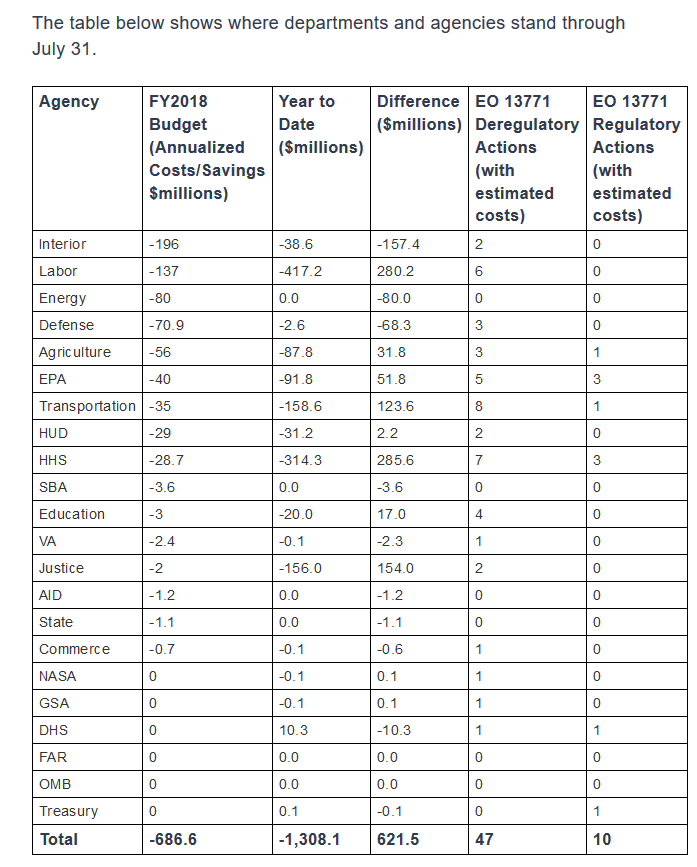“Report: Regulations Being Cut at Record Pace, S
Post# of 65629


President Donald Trump speaks during an event on federal regulations in the Roosevelt Room of the White House, Thursday, Dec. 14, 2017, in Washington. "Let's cut the red tape, let's set free our dreams," Trump said as he symbolically cut a ribbon on stacks of paper representing the size of the regulatory code.
“‘With less than two months remaining in FY 2018, the Trump administration is well on its way to surpassing its regulatory budget goals,’ said the new report from American Action Forum, which charts federal regulations.”
Federal agencies, led by Labor and Health and Human Services, are cutting Obama-era regulations and saving money faster than demanded by President Trump, according to a new report.
And as a result, the administration is expected to easily meet the president’s order to cut at least two old regulations for every new one issued and cut the costs of regulations.
“Collectively, executive agencies subject to a regulatory budget remain on pace to double the administration’s overall savings goal. On an individual basis, 12 of 22 agencies have already met or surpassed their savings target,” added the report written by Dan Bosch, the director of regulatory policy at the American Action Forum.
“Collectively, executive agencies subject to a regulatory budget remain on pace to double the administration’s overall savings goal. On an individual basis, 12 of 22 agencies have already met or surpassed their savings target,” added the report written by Dan Bosch, the director of regulatory policy at the American Action Forum.
He highlighted the winners:
“The Department of Labor (DOL) enjoys the largest total savings of covered agencies with $417.2 million. The Department of Health and Human Services (HHS) comes in second in savings, but has a larger savings surplus (or the amount in excess of its FY 2018 target) than DOL at $285.6 million. The Department of Transportation (DOT) ranks third in annualized savings followed closely by the Department of Justice.”
Interior has dug the biggest hole, but Bosch said that a key deregulation under consideration would help that agency catch up.
The annualized savings to date come from final rules published in the Federal Register that are identified as deregulatory or regulatory actions under Executive Order (EO) 13,771 and include a quantified costs or savings estimate. Agencies may have categorized some rules as either deregulatory or regulatory but only provided a qualitative cost/benefit analysis, and these rules fall outside the scope of this analysis.
The Department of Labor (DOL) enjoys the largest total savings of covered agencies with $417.2 million.
The Department of Health and Human Services (HHS) comes in second in savings, but has a larger savings surplus (or the amount in excess of its FY 2018 target) than DOL at $285.6 million. The Department of Transportation (DOT) ranks third in annualized savings followed closely by the Department of Justice.
The Department of the Interior (DOI) finds itself in the largest hole at $157.4 million under its savings target.
DOI could reverse this shortfall, however, as a final rule is currently under review at the Office of Information and Regulatory Affairs that, if finalized as proposed, would produce annualized savings of $227 million. According to the Unified Agenda, the rule was expected in July, so it seems possible the rule will still be finalized in FY2018.
The Department of Energy seems to be in a more precarious spot. It has yet to finalize any deregulatory actions with a savings estimate, so it remains $80 million short of its goal. Unlike DOI, there is no clear rule in the pipeline that would achieve the outstanding savings. The Departments of Defense and Homeland Security are in a similar position.
Under EO 13,771 and subsequent OIRA guidance, agencies that fail to meet their budget target in the current fiscal year must develop a plan to come into compliance, and explain why they failed to do so. Based on current evidence, it appears we are likely to see how this process plays out for the first time.
Action Counts
A separate component of EO 13,771 is the requirement that agencies finalize two deregulatory actions for each regulatory action. Looking at those actions with estimated costs, agencies should collectively surpass this goal by a wide margin. Notably, the administration also counts deregulatory actions and changes to guidance documents that don’t include a cost estimate, so it is likely that at the end of FY2018 the administration’s deregulatory ratio will be higher than the one found in this analysis.
Based on our list of 47 deregulatory actions, DOT leads all covered agencies with eight. HHS and DOL follow with seven and six actions respectively. Five agencies have yet to issue a deregulatory action with estimated savings.
As the list of the relatively few regulatory actions in the table above indicates, the administration does not count every regulation as a regulatory action. Instead it counts significant regulations except those that qualify for an exemption for a compelling reason, such as national security or an emergency.
Therefore, one should not jump to the conclusion that regulatory actions have come to a halt. Through July 31, 2,024 rules were published in the Federal Register, according to Regulations.gov. Many of these are mundane, yet necessary, rules such as airworthiness directives for airplanes, Coast Guard regulations that allow for special events and usage in major waterways, and mandated rate changes in Medicare and Medicaid programs.
Conclusion
With less than two months remaining in FY2018, the Trump Administration is well on its way to surpassing its regulatory budget goals, yet on an individual basis, a few notable agencies have substantial work to do. It will be worth watching to see if these agencies ramp up their deregulatory activity to maximize their savings ahead of September 30.

https://www.washingtonexaminer.com/washington...ngs-double
https://www.americanactionforum.org/experts/dan-bosch/
 (0)
(0) (0)
(0)